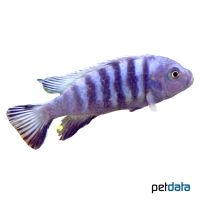Cynotilapia-Hara Reef (Cynotilapia sp. 'Hara')
| Cynotilapia-Hara Reef Cynotilapia sp. 'Hara' | |
|---|---|
| Name | Cynotilapia-Hara Reef |
| Name Lat. | Cynotilapia sp. 'Hara' |
| Family | Cichlids |
| Family lat. | Cichlidae |
| Order | Cichlids |
| Order lat. | Cichliformes |
| Origin | Lake Malawi |
| Habitat | Rocky intermediate zone |
| Diet | Planktivore, Aufwuchs |
| pH | 7.5-8.8 |
| Behavior | Territorial |
| Keeping | Harem |
| Care Level | Moderate |
| Reproduction | Mouthbrooder |
| Breeding | Simple |
| Life Span | 6-10 years |
| Protection | No |
| Metric Units | |
| Size | 8-10 cm |
| Temperature | 24-28 °C |
| Hardness | 10-25 °dH |
| Aquarium | ~ 250 l |
| US Units | |
| Size | 3"-4" |
| Temperature | 75-82 °F |
| Hardness | 178-445 ppm |
| Aquarium | ~ 65 gal |
Distribution and habitat
The distribution area of the Cynotilapia-Hara Reef is exclusively (endemic) Lake Malawi, where they are found only in the northwest near Chilumba on Gallireya Reef. They belong to the group of mbuna that live in the caves and niches of the rubble zone near the shore
Maintenance
The aquarium setup should have rocky structures, with plenty of crevices, caves and shelters to provide hiding places, with open sandy areas as well as plenty of free swimming space. A light sandy substrate with some robust plants is ideal
No ammonia, ammonium or nitrite should be detectable, and nitrate levels should not exceed 100 mg/l. To ensure the water quality and oxygen content, a filter and heater adapted to the aquarium size is required, as well as lighting for the species-appropriate day-night rhythm of the animals.
Diet
They feed mainly on plankton as well as on the plant cover (growth) and the microorganisms contained therein. The food supply consists of live, frozen and dry food. For a balanced diet, feed once daily with a high quality dry food for Malawi cichlids (flakes, granules, pellets) as well as cyclops, daphnia, artemia and plankton (live or frozen). In addition, they also need plant food, such as algae leaves, scalded leafy and wild vegetables or high-quality dry food with plant components (kelp, spirulina)
Only feed as much as will be eaten within a few minutes. A regular and varied diet promotes health and increases resistance.
Behaviour and compatibility
These lively and assertive mbuna with high intraspecific aggression, males vehemently defend their territory, should be kept in a harem, one male with several females, or better in a large group. Thereby social structures are formed, which reduce quarrels. They can be socialized with other robust Malawi cichlids, especially from the mbuna group. Basically, only compatible fish species with similar demands on water conditions and water temperature should be socialized.
Sex dimorphism
The larger and more colorful males have yellow egg spots on the anal fin, which are weaker or absent in the smaller females
Reproduction and breeding
They are maternal mouth brooders. The female spawns 15-30 eggs in a cave or sand pit and immediately takes the eggs into her throat sac for mouthbrooding. She retains the fry in her throat sac even after hatching. After about 3 weeks, the fry are released and brood care ends. During the entire brood care, the female does not eat any food. The fry grow very slowly.
Fry must be fed several times a day with special rearing food (Artemia nauplii). In a community tank breeding is hardly possible, because the fry are easy prey.
Important
There should be at least one small den for each adult male to form his territory around and numerous rocks to provide hiding places for females and juvenile males.
In the wild, females and juvenile males form large flocks
The well-being of the fish should be checked regularly. Temperature should be checked daily, pH, hardness and nitrate levels at least every 14 days. Regular partial water changes are recommended, even when contaminant levels have not yet reached the upper limit. Sudden changes in water quality should be avoided. Newly introduced fish must be accustomed slowly to the water in the aquarium.
Further literature can be found in your pet store.
References
Text: Werner Winter; Image: petdata
Source: BMELV (1998): Tierschutzgutachten - Haltung von Zierfischen (Süßwasser); BAENSCH & RIEHL (2004): Aquarien Atlas Bd. 2, Mergus Verlag; ENGELMANN (2005): Zootierhaltung - Tiere in menschlicher Obhut: Fische, Verlag Harri Deutsch
- Gemäß § 21 Abs. 5 Tierschutzgesetz idgF
